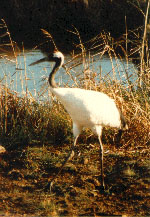|
|
|
|
A National Treasure Saved: The Japanese Crane
|
|
|
|
|
|
|
 |
|
|
|
Like the Bald Eagle of America or the Cara Cara Eagle of Mexico, the Japanese Crane is a vital symbol in Japan. Elegant, graceful, delicately beautiful, the crane has been a subject of Japanese arts and folk tales for centuries.
But the Japanese crane ("Tancho," in Japanese, or "Grus japonensis" in scientificese) came dangerously close to extinction. Commonly seen throughout Japan until the end of the Edo period (1600-1867), the cranes began to disappear through the Meiji period (1868-1912). By 1924, only 10 cranes were found in Kushiro Marsh, a vital wetlands and crane nesting area near Kushiro in eastern Hokkaido. Local farmers and residents began a concentrated effort to protect and preserve this national treasure that can be found only in Japan, the Amur Basin of Russia and northeastern China.
|
|
|
A Tancho Crane in the Japanese Crane Reserve
|
|
|
 |
|
|
|
In 1952, the Tancho was designated a special national monument, and in 1958 the Japanese Crane Reserve opened with five birds in Tsuruoka, in Kushiro. Population studies began in 1952, finding only 30 birds, and have continued to take place each year documenting the remarkable return of the crane. It's estimated that in Hokkaido there now resides over 600. Beginning with little scientific and naturalist's knowledge of these animals, one man set out to learn and rescue the nearly extinct Tancho—Mr. Takahashi.
After a decade of dedicated work, involving experts from around the world, Mr. Takahashi succeeded in producing the first natural hatchlings in 1970. Since then, his hatching method, starting with his two original cranes, Tan and Mau, has successfully resulted in the re-propagation of this national treasure.
|
|
|
|
The crane's life span is similar to humans. At the center, the oldest crane is now 36 years old. As a rule, they mate for life. Mr. Takahashi told us an unusual story about how if one crane of a mated pair dies, the survivor will protect the corpse for a long period. If the corpse is belly side up, the survivor will "remarry" as if it recognizes the death, but if the corpse is belly side down, the survivor will not remarry.
|
|
|
Mr. Takahashi. Dr. Hata and George discussing the rescue of Tancho Cranes.
|
|
|
In mid-March of each year, cranes leave their feeding grounds and move into marshes and wetlands to begin making their very large nests from reeds. They will then lay one or two eggs (10 cm or 4 inches). Both the male and female take turns incubating the eggs, and in 32 days the eggs hatch. Mr. Takahashi said he has found that at 20 days, the eggs will respond to his voice.
The cranelets grow rapidly, achieving their parent's size within 100 days, and soon after learn to fly. But they will not reach sexual maturity until they are 3 years old. Once they have "married," they will produce a hatchling every year. At the present time there are 607 mated cranes in Japan.
Mr. Takahashi's passion and dedication for nearly 40 years is nothing short of remarkable. He lives for the cranes, and is the world's leading authority on them. When he talks about them or the preserve and facility he has created for them, his passion shows. He can move like the crane, read their behaviors, and makes all their vocalizations in a way that even convinces the crane he is one of them.
And it is his passion which makes the Tancho Protection and Propagation Center a success for the cranes and for the world. The center now has 20,000 visitors each year, and their admission fees are the primary means of supporting the facility.
|
|
|
|
|
|
|
|
|
|
|
|
|
|
|
|
|
|
|
|
|
|